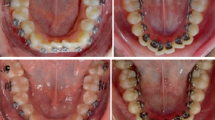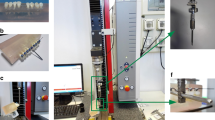Abstract
Background and Aim:
Over the last few years, lingual appliances have become an established orthodontic treatment technique. Many studies have concentrated on various esthetic aspects, on laboratory and clinical procedures, and on patient comfort and compliance. The orthodontic force systems of these appliances, however, have not yet been investigated. The aim of this study was thus to determine the forces and moments produced by a new lingual bracket system during the leveling phase of orthodontic treatment and to compare those with the corresponding force system of a labial straight-wire appliance.
Material and Method:
The intra-oral situation of ten patients undergoing orthodontic treatment was replicated in measurement casts fitted with lingual and labial brackets. Special care was taken to precisely reproduce each patient’s interbracket geometry. We measured each tooth’s force systems as generated by a leveling arch inserted into the lingual and labial brackets.
Results:
The resulting force systems of both appliances were found to be quite similar with regard to the magnitude of most force and moment components. Only the first molars were subjected to considerably greater single forces with the lingual appliance. Tipping moments were found to be significantly smaller with the lingual technique, whereas the rotational moments were significantly smaller with the labial appliance. All in all we noted significant differences between the two techniques only in certain areas which upon closer examination were distributed over only a few tooth types.
Conclusions:
The initial force systems produced by the new lingual bracket system proved to be comparable with those delivered by a conventional straight-wire appliance. The actual levels of forces and moments, however, were found in certain cases to be too heavy with both techniques. We therefore recommend the development of leveling wires producing considerably lighter forces and moments.
Zusammenfassung
Hintergrund und Ziel:
In den vergangenen Jahren konnte sich die Lingualtechnik als eigenständige orthodontische Behandlungstechnik etablieren. Die bislang erschienenen Publikationen heben die ästhetischen Vorteile dieser Behandlungstechnik hervor und beschreiben klinische und labortechnische Prozesse sowie Aspekte des Patientenkomforts und der Compliance. Bisher sind jedoch noch keine Untersuchungen der orthodontischen Kraftsysteme dieser Apparaturen vorgenommen worden. Ziel dieser Arbeit war daher die Erfassung der während der Nivellierungsphase mit einem neu entwickelten Lingualbracketsystem auftretenden Kräfte und Drehmomente und der Vergleich mit den entsprechenden Kraftsystemen einer Straight-Wire-Apparatur.
Material und Methode:
Bei zehn kieferorthopädischen Patienten wurde die intraorale Situation auf ein Messmodell übertragen. Die Modellzähne wurden mit labialen und lingualen Brackets versehen, wobei die individuelle Interbracketgeometrie des einzelnen Patienten besonders berücksichtigt wurde. An jedem Zahn wurden für beide Bracketsysteme die von einem Nivellierungsbogen verursachten Kräfte und Drehmomente experimentell bestimmt.
Ergebnisse:
Die resultierenden Kraftsysteme waren in beiden Behandlungssystemen unter Berücksichtigung der Einzelkomponenten Kraftgröße und Drehmoment nahezu identisch. Lediglich die ersten Molaren wurden in der Lingualtechnik mit signifikant größeren Einzelkräften belastet. Für die Drehmomente ergaben sich signifikant kleinere angulatorische Momente in der Lingualtechnik und signifikant geringere rotatorische Momente in der Bukkaltechnik. Insgesamt zeigten die Ergebnisse nur in wenigen Bereichen signifikante Unterschiede zwischen den resultierenden Kraftsystemen beider Behandlungstechniken, die sich bei genauerer Betrachtung auf einige wenige Zahntypen verteilten.
Schlussfolgerungen:
Die initialen Kraftsysteme der neuen Lingualbrackets sind mit denen eines konventionellen Straight-Wire-Systems weitgehend vergleichbar. Dennoch müssen die resultierenden Kräfte und Drehmomente in Einzelfällen bei beiden Techniken als sehr hoch bezeichnet werden. Die Entwicklung ortho dontischer Bögen, die in der Nivellierungsphase der Therapie wesentlich kleinere Kräfte und Momente erzeugen, sollte daher angestrebt werden.
Similar content being viewed by others
Author information
Authors and Affiliations
Corresponding author
Rights and permissions
About this article
Cite this article
Fuck, LM., Wiechmann, D. & Drescher, D. Comparison of the Initial Orthodontic Force Systems Produced by a New Lingual Bracket System and a Straight-Wire Appliance. J Orofac Orthop 66, 363–376 (2005). https://doi.org/10.1007/s00056-005-0442-3
Received:
Accepted:
Issue Date:
DOI: https://doi.org/10.1007/s00056-005-0442-3




